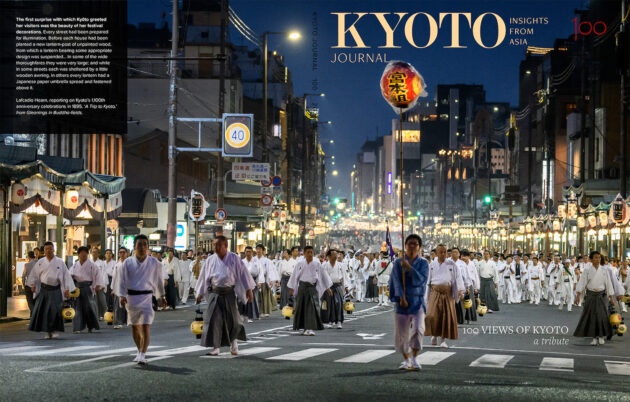
Additional views / visions of Kyoto – an ongoing project complementing KJ100, ‘100 Views of Kyoto – a Tribute.’

On this page we present additional views, impressions and visions of Kyoto, as an ongoing project complementing our print edition, KJ100: ‘100 Views of Kyoto – a Tribute.’
Kyoto View 18: Finding Home – Lauren W. Deutsch
When I passed a huge statue of Kannon, standing guard 24/7 by the door of one of the many
Buddhist temple supply shops now closed for the day, I knew I was close. Breathing a sigh of relief, I announced to the granite, “Honey, I’m home!”
Kyoto View 83: Kyoto Organic – Kobayashi Mai
Many young “organic” (both certified and non-certified) farmers have established themselves in Ohara, a farming community less than 20km northeast of central Kyoto. Supporting their success is the Ohara Sunday morning market.
KJ View 84: Neighbors [KJ5]
A poem from Robert MacLean, paired with a print by Richard Steiner, dating back to 1988.
Kyoto View 85: Mizuno Matsuhiko and Kayu, Father and Daughter Photographers – interviewed by John Einarsen
“I favor places where there is harmony between human-made things — like the place we live now, machiya, of course temples — and nature. Where they are mixed in harmony — that is Kyoto. The charm of Kyoto is where nature fuses well with the human-made.”
Kyoto View 86: Kyoto Dwelling, by Edith Shiffert – review by Margaret Chula [KJ7]
“Since I came to Kyoto in 1963, much has changed, but even more has not changed. They are the things written about here, at the moments when they were experienced.”
Kyoto View 87: Viewing the Famous Scenes of Kyōto in Meisho Zue – Ken Rodgers
…the Miyako Meisho Zue was a best-seller in its time, though its large format and many volumes probably made it impractical as a handbook for on-site reference. Instead, it allowed well-to-do purchasers to remain comfortably at home, avoiding the rigors of actual travel in those pre-Shinkansen days, while vicariously enjoying all the most notable attractions of Kyoto.
Kyoto View 88: Structures of Kyoto, Interrogated – A review of Writers in Kyoto Anthology 4, by Patrick McCoy
As was the case with WiK’s previous anthologies, it is an eclectic collection that includes fiction, nonfiction, prose, poetry, photographs and illustrations, this time around on the theme of “structures of Kyoto.”
Kyoto View 89: Kyoto-tomason: the Hunt for Hidden Hyperart – Sylvain Cardonnel
I had been taking pictures of these strange silhouettes encountered in Kyoto for a long time without knowing what to name them. Later, I learned that what I was photographing was “hyperart-tomasons” (chôgeijutsu-tomason), and that Akasegawa Genpei (1937-2014) had been the facetious inventor of this concept…
Kyoto View 90: an excerpt from Gleanings in Buddha-fields by Lafcadio Hearn
On the back cover of KJ 100 is a short quote from the celebrated Meiji-era writer Lafcadio Hearn, describing lantern decorations he saw when visiting Kyoto (from his home in Kumamoto) for its 1100th anniversary celebrations in 1895. He recorded his impressions of Kyoto in a multi-part essay anthologized in his 1897 book Gleanings in Buddha-fields…
Kyoto View 91: The Dento Bento by Jonah Salz, from KJ 3
A packaged culture show may be called a “dento bento,” because of the function it serves for the hurried tourist. Taken out of original social, religious, and political contexts, traditional culture is cut and dried, artificially sweetened and colored.
Kyoto View 92: A Postcard by Tiery Le,..
Readers who ordered KJ100 received various selected bonus inserts (as a way of celebrating this centennial issue); among them was a unique, specially-designed postcard by local artist and long-time KJ contributor Tiery Le,..
The updated and extended digital (PDF) version of KJ100, incorporating these and other new views, is now available, here.
A Definitive Ranking of the Ducks of Kamogawa – Sarah Sawamura
For most of us here in Kyoto, peace of mind is often found along the banks of the Kamogawa River… But have you ever wondered, who are the namesake residents of this Duck River? We’ve taken the liberty of identifying the most common species of duck inhabitants, and ranking them from ugliest little duckling, to virtual bird of paradise.
Kyoto’s Forgotten Era – Hal Gold, KJ 70 (Kyoto Lives)
Some months after the Restoration news came that the emperor was leaving on a journey.The emperor answered with an imperial denial: “I am going to Edo to change its name to Tokyo. I shall return.” This year is the 140th anniversary of the emperor’s promise. Kyotoites are still waiting.
A Sense of Place – Gunter Nitschke, KJ 4, Fall 1987
Of all cities in East Asia, Kyoto has the oldest and probably the strictest official preservation policy. In stages it has enacted planning legislation which in one way or another preserves close to three quarters of the municipal domain.
Mapping Kyoto: An Affair of the Heart – Judith Clancy interviewed by Hana Murrell [KJ79]
“Kyoto city is an affair of the heart for me. I love the history, the art, design sense, spatial images, space of houses, safety and quiet. I like Japanese standards of humanity, morality, safety, friendship… Kind of 19th century ideas perhaps, but they suit me.”
Kyoto Rain – Diane Durston, KJ 27, Spring 1994
The people are what this city — any city — is really all about. The people and the way they live in the old neighborhoods: close and comfortable. Comfortable in the sense of feeling always at home.
Ima Tenko – Elle Murrell
Ima Tenko is an acclaimed veteran of the ‘butoh’ dance movement, an avant-garde form that emerged in Japan in the 1950s to challenge the popular aesthetics of that era. Her subversive art is virtually impossible to define; it’s a theatre of protest, assault on the senses, bewildering, visually raw, emotionally overwhelming, a startling cultural export, and, to Ima, “an opportunity to explore the frontiers of my art and self.”
Somushi: The Story of Kyoto’s First Korean Teahouse – Kyoko Yukioka
The building housing Somushi Korean teahouse on Karasuma Street has a dignified air about it. Perhaps it is the thick roofed mud wall that encircles it or the ornate bronze shutters that adorn the three-story façade, but regardless it seems in tune with the prestige of its proprietors: the famous obi maker Kondaya Genbey, established in the 1700s.
Kyoto’s Festivals: Twelve Months of Everyday Transience – Ken Rodgers KJ 50 (Transience)
In Kyoto, one grows accustomed to the ongoing round of festivals at Buddhist temples and Shinto shrines—it’s said that you could attend at least one every day here, throughout the year… formal annual ceremonies and rituals that commemorate specific seasonal events or historical personages, some dating back well over a thousand years
The Path to Honen-in – John Dougill, KJ 70 (Kyoto Lives)
Nestled at the foot of the eastern hills, the small temple of Honen-in is a tranquil oasis of green. It stands on the spot where the great Kamakura reformer, Honen Shonin (1133-1212), used to pray six times a day before a statue of Amida.
Mantra from Ajari-san – Sherry Nakanishi, KJ 57, Fall 2004
Ajari — in full, Daigyoman Ajari, meaning “Great Teacher” — is a title conferred on monks of the Tendai sect who have completed the great sennichi kaihõgyo training on the sacred trails of Mount Hiei, Kyoto, walking a total of over 38,000 kilometers in 1,000 days, within a seven-year period.
A House Living with Tea – Alexandra Ting
For an architect, an engineer, and an office worker, a lifestyle centered around tea appears at odds with their day-to-day routines. But when the housemates are not working, they come together to host events for family and friends and some that are open to the public.
Setsubun Girl
On the first day of spring—which falls at the beginning of February—after throwing beans and playing at devils, we went to Mibu Temple in Kyoto. We stood in line for the better part of a cold hour, then sat down in the outdoor theater to see the eleventh-century pantomine named for this day: Setsubun.
The Lists of a Lady-in-Waiting – David Greer, KJ 45, Fall 2000
A thousand years ago a lady-in-waiting in the imperial court at Heian Kyo (modern-day Kyoto) dipped her brush into the well of her inkstone and watched the bristles swell with ink. She lowered the brush onto the paper spread in front of her and moved her hand rapidly:
Haru wa akebono . . . In spring, the dawn. The sky, dyed in morning light, slowly brightens and purple clouds stretch across the mountains. . .

KJ managing editor